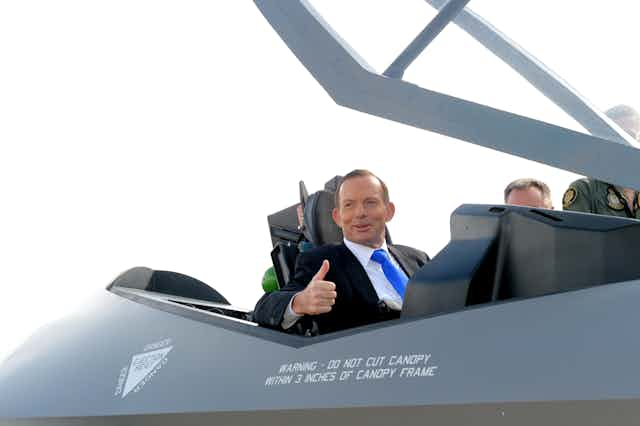Prime Minister Tony Abbott sat in the pilot seat of a F-35 Joint Strike Fighter at the time he announced his government will buy an additional 58 planes at a cost of at least A$12.4 billion. But imagine if there was no need for a pilot to fly inside the so-called fifth generation aircraft.
The F-35 is said to be the smartest and most complex fighter jet on the planet, designed to conduct lethal strikes on air and ground targets without being detected by radar.
But its development has been beset by delays and cost overruns and it is not clear whether this aircraft is best suited to the task.
Indeed, it’s not even obvious that we need a human in the loop.
Do we really need a pilot?
What we need is analysis to consider whether we have the right balance between piloted, optionally piloted and remotely or even automatically (autonomous) piloted systems planned for the future defence and air force structure.
Optionally piloted is where there is still a pilot on board but they can leave some of the aircraft’s operations to its computer systems. A preference for the latter remote or autonomous options might lead to cost savings or strategic benefits.

While Lockheed Martin has not yet officially confirmed the development of a pilotless or optionally piloted version of the F-35, Boeing has already converted several F-16 fighter jets into drones.
Bob Rubino, Lockheed’s director of Washington operations for the JSF program, has also let on that the company’s Skunk Works research and development lab is “constantly looking at all kinds of things”.
The US Naval Institute has already pointed out that an optionally piloted F-35 would hold many advantages.
With a pilot in its seat, the aircraft can concentrate on the task of flying while the pilot gathers intelligence or operates the aircraft’s extensive command and control suite.
This has the potential to enhance decision-making and reduce casualties in armed conflict.

Without a human in the cockpit in the remotely or automatically piloted version, the potential benefits are magnified, as the aircraft would be able to perform riskier missions in support of international security.
Without the need for an ejector seat and other life support systems, the F-35 would also be able to significantly increase its weapon or sensor payload, or fly higher for an extended duration.
Over time, pilotless systems may also prove cheaper to buy and operate with reduced training and maintenance requirements, and the option for a multi-system control interface through which one operator can simultaneously oversee several drones.
BAE Systems has already revealed that it has successfully test-flown the Taranis, a highly autonomous prototype drone.
But the best indication of what is to come for the JSF has been provided to me by industry insiders who have suggested that a pilotless conversion is inevitable (if not already underway).
The F-35 is a prime candidate as a fifth generation fighter aircraft with reports of up to 10 million lines of computer code controlling its flight surfaces, engine and weapons systems. That’s more than six times the amount of the 1.7 million lines of code in its piloted cousin, the F-22 Raptor.
In essence, the computer already does much of the tough flying and the F-35 aircraft could serve as bridge to test other dedicated combat aircraft, with any lessons learned being applied to other unmanned combat aircraft of the future Australian Defence Force.
The machines taking over
Of course, beyond the technical survey and typical cost-benefit analysis, the government also needs to consider the higher level moral, political and strategic costs of employing such novel technologies.

A host of questions go largely unanswered: are pilotless systems capable of discriminating between a fisherman displaying his catch and an angry Somali pirate holding a rocket propelled grenade, or between an Iraqi child playing in the street with a toy gun and a child soldier wielding an AK-47 assault rifle?
Do drone operators benefit from improved situational awareness or is it more like trying to conduct a sword fight in a telephone booth while looking through a toilet paper tube?
Will there be psychological consequences for the operators of these systems if they can see events unfold in real time but are unable to intervene? That is, how mentally and morally disturbed will an operator be when he or she has no option other than to watch an innocent person walk into the ‘kill zone’ of a missile strike?
Some psychologists have proposed that we develop a Siri-like like user interface or virtual co-pilot to allow operators to shirk the blame for any collateral damage.
Australia surely has a right to minimise harm to its troops and reduce other costs, but if war and combat can be reduced to saying “Siri, go kill those people”, will this dehumanise and possibly aggravate our enemies?

